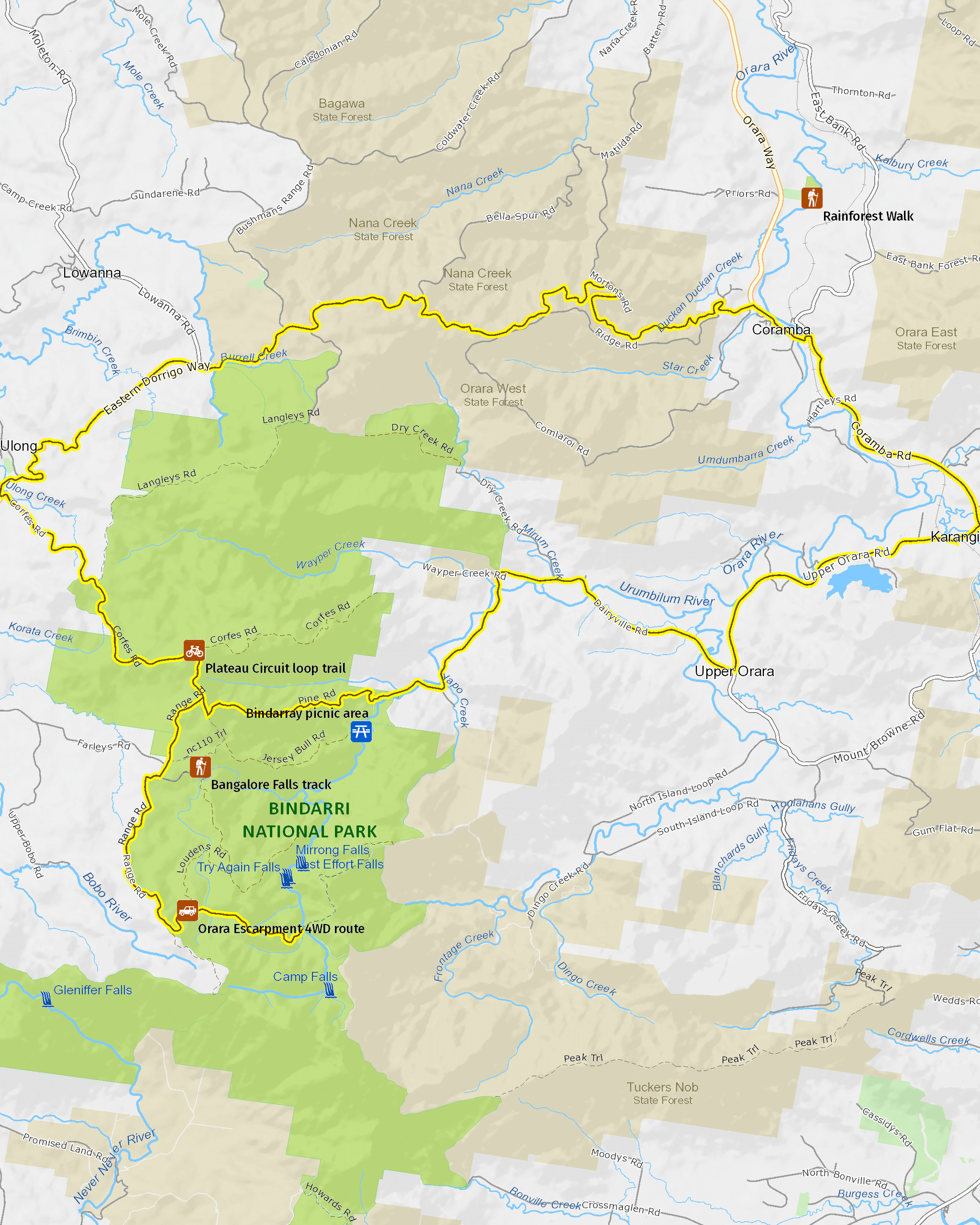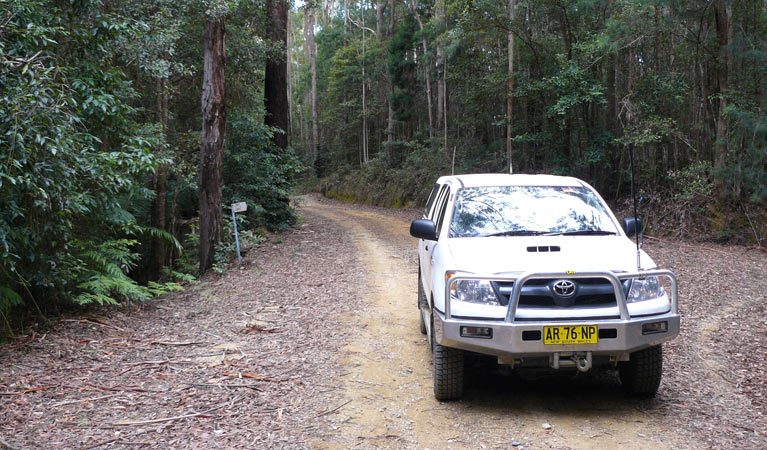Overview
Orara Escarpment 4WD touring route goes from Coffs Harbour through pristine forest, with spectacular waterfalls and idyllic picnic and swimming spots along the way.
- Distance
- 80km
- Time suggested
- 3hrs
- Grade
- Medium
- What to
bring - Drinking water, hat, sunscreen
- Please note
Check the weather before you set out as Orara Escarpment 4WD touring route relies on dry weather-only roads
Orara Escarpment 4WD touring route is a great day trip for the whole family. The 80km round-trip from Coffs Harbour travels through remote eucalypt forests and subtropical rainforests, with plenty of picnic and swimming spots along the way.
Climb over 600m as you make your way up the Orara Escarpment, then drive through rainforest and eucalypt forest to the spectacular Bangalore Falls. Stand on the lookout, listen to the waterfall, and take in the dramatic views.
Stop for a picnic here, or continue through subtropical rainforest to Urumbilum picnic area. Make sure you take a short walk downstream to discover Urumbilum Falls.
Head back through tree ferns, hoop pine and cabbage tree palms on Range Road and see magnificent old-growth forest along Langleys Road. If you enjoy birdwatching, keep your eyes out for lyrebirds, bush turkeys and glossy black-cockatoos along the way.
Also see
-

Plateau Circuit loop trail
Cycle through lush subtropical rainforest and eucalypt forest. See spectacular waterfalls and enjoy beautiful picnic and swimming spots, close to Coffs Harbour.
-

Bindarray picnic area
Escape the crowds and head to Bindarray picnic area. Enjoy 4WD touring, birdwatching, wildlife watching, swimming, liloing, paddling and picnicking by Urumbilum River.
Map

Map legend

Local alerts
For the latest updates on fires, closures and other alerts in this area, see https://www.nationalparks.nsw.gov.au/things-to-do/4wd-touring-routes/orara-escarpment-4wd-touring-route/local-alerts
Park info
- in Bindarri National Park in the North Coast region
Bindarri National Park is always open but may have to close at times due to poor weather or fire danger.
- in Bindarri State Conservation Area in the North Coast region
Visitor info
All the practical information you need to know about Orara Escarpment 4WD touring route.
Getting there and parking
Get driving directions
Orara Escarpment 4WD touring route starts in the eastern precinct of Bindarri National Park. To get there:
- Follow the directions to the park entrance via Dairyville Road
- Take Pine Road up the escarpment and continue to Bangalore Falls on Bangalore Road
- Continue on Range and Urumbilum Creek roads to Urumbilum picnic area and Urumbilum Falls
- Return the same way, or drive back on Range Road, then take Corfes Road and Langleys Road which brings you to Eastern Dorrigo Way, east of Ulong.
Parking
Parking is available along Orara Escarpment 4WD touring route.
Best times to visit
There are lots of great things waiting for you in Bindarri National Park. Here are some of the highlights.
Autumn
Get off the beaten track and take your 4WD through pristine bushlands, stopping to see the magnificent Bangalore Falls.
Spring
Enjoy picnicking and swimming by the river and easy walking to see spectacular waterfalls.
Summer
Take a refreshing swim in the crystal clear waters of Urumbilum River.
Winter
Head off on your mountain bike and explore the remote forest trails.
Weather, temperature and rainfall
Summer temperature
Average
18°C and 27°C
Highest recorded
43.3°C
Winter temperature
Average
7°C and 20°C
Lowest recorded
-3.2°C
Rainfall
Wettest month
March
Driest month
September
The area’s highest recorded rainfall in one day
781.9mm
Maps and downloads
Permitted
Fishing
A current NSW recreational fishing licence is required when fishing in all waters.
Prohibited
Gathering firewood
Pets
Pets and domestic animals (other than certified assistance animals) are not permitted. Find out which regional parks allow dog walking and see the pets in parks policy for more information.
If you're travelling through a national park or reserve on a public road you can have pets inside your vehicle. However, you must keep them inside your vehicle while driving through national parks or reserves. You must also comply with any conditions in the park’s plan of management, and you cannot stop to visit the park or use park facilities (unless for safety reasons, or to use publicly accessible toilets).
Smoking
NSW national parks are no smoking areas.
Learn more
Orara Escarpment 4WD touring route is in Bindarri National Park. Here are just some of the reasons why this park is special:
A bygone era

Walking out to Bangalore Falls, you might notice the large stumps standing as reminders of the parks former days of logging. Known as the 'cedar getters', the first Europeans arrived in this region in the mid-1800s. However, logging did not start until 1863. By 1880, concerns that Orara Valley would be cleared called for the declaration of Forest Reserve No 642, which later became Orara West State Forest in 1917.
Biodiversity hotspot

Bindarri National Park is considered a ‘biodiversity hotspot’ due to the number of rare and threatened species found here, such as the palm orchid, fish bone fern and southern quassia. The park also provides an important corridor of native vegetation linking the hinterland and plateau habitats of the World Heritage-listed Dorrigo National Park with the coastal habitats of Bongil Bongil National Park. It's also home to a range of wildlife including an abundance of bird species,wallabies, possums and spotted-tailed quolls, as well as threatened species such as koalas, platypus, owls and bats. You might also spot the brown-speckled giant barred frog or the giant panda snail - the largest snail in Australia,with a shell measuring up to 12cm long.
- Bangalore Falls walking track Bangalore Falls is a must-see destination with superb waterfall views from the lookout, just a short walk along an easy walking track, and a great place for a picnic.
- Bindarray picnic area Escape the crowds and head to Bindarray picnic area. Enjoy 4WD touring, birdwatching, wildlife watching, swimming, liloing, paddling and picnicking by Urumbilum River.
- Orara Escarpment 4WD touring route Orara Escarpment 4WD touring route goes from Coffs Harbour through pristine forest, with spectacular waterfalls and idyllic picnic and swimming spots along the way.
- Plateau Circuit loop trail Cycle through lush subtropical rainforest and eucalypt forest. See spectacular waterfalls and enjoy beautiful picnic and swimming spots, close to Coffs Harbour.
Traditional Aboriginal lands

The deep gorges, cascading waterfalls and lush forests of Bindarri National Park are the traditional lands of the Gumbaynggirr people. The park is named after the Gumbaynggirr word 'Bindarray', which means 'many creeks'. Many Aboriginal sites have been identified as places used by local Aboriginal people for camping, tool-making, ceremonies and dreaming stories.
Operated by
- Coffs Harbour office
- Monday to Friday, 8.30am to 4.30pm.
- 02 6652 0900
- npws.coffscoast@environment.nsw.gov.au
- 4/32 Edgar St, Coffs Harbour NSW 2450
Park info
- in Bindarri National Park in the North Coast region
Bindarri National Park is always open but may have to close at times due to poor weather or fire danger.
- in Bindarri State Conservation Area in the North Coast region
What's nearby:
Things to do (34)
- 4WD touring (2)
- Aboriginal culture (2)
- Birdwatching and wildlife encounters (12)
- Canoeing/paddling (3)
- Cycling (4)
- Educational activities (1)
- Environmental appreciation/study (1)
- Fishing (3)
- Historic heritage (2)
- Picnics and barbecues (5)
- Road trips and car/bus tours (3)
- Sightseeing (15)
- Surfing (2)
- Swimming (3)
- Walking (18)
- Waterfalls (13)

